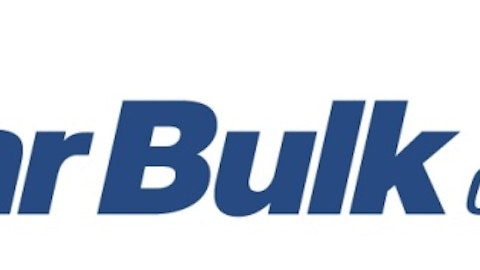
Business model
DryShips Inc. (NASDAQ:DRYS) is engaged in the transportation of dry bulk and petroleum cargoes globally. Its industry peers like Diana Shipping Inc. (NYSE:DSX) and Nordic American Tanker Ltd (NYSE:NAT) are operating in a single segment. Diana Shipping Inc. (NYSE:DSX) is only involved in the transportation of dry bulk cargoes, including commodities like iron ore and coal, while Nordic American Tanker Ltd (NYSE:NAT) is engaged in acquiring and chartering of Suezmax tankers only.
DryShips Inc. (NASDAQ:DRYS) is already losing money from the dry bulk segment due to decline in book orders, but now the price of crude oil is rising. The increasing price level will negatively affect DryShips oil tanker segment in the future. The diversification of DryShips in both the dry bulk and the oil tanker business is good, but not during the recession. The diversification will be helpful for DryShips Inc. (NASDAQ:DRYS), only if the demand for both the dry bulk and the oil tanker vessels will improve simultaneously. This seems difficult as the price of crude will continue to rise because of the increasing cost of extraction. The demand for dry bulk ships will also reduce as China is now trying to reduce coal consumption by using alternative sources to generate electricity.
Rising crude oil prices
The current price of crude oil is $105 per barrel, which jumped from $97 per barrel a month earlier. The U.S. Energy Information Administration (EIA) expects that the price for crude oil will average $108 per barrel in 2013. The cost of oil extraction is also rising and it is projected that world oil production costs are increasing at about 9% per year. This depicts that the crude oil price will further rise. The rise in crude’s price will negatively affect DryShips Inc. (NASDAQ:DRYS) as the increasing fuel prices lead to high shipping costs. As a result, Shipping firms often pass on oil price charges to its customers which in turn will reduce the demand for ships.
The rise in crude oil price will negatively affect the DryShips tanker segment. As the price is rising, the demand for crude oil will decrease because the consumers will not be motivated to buy oil at a higher price. The poorer demand will in turn reduce oil imports, which will reduce shipping rates. The rise in crude oil price will significantly disturb Nordic American Tanker Ltd (NYSE:NAT) because it operates oil tankers while Diana Shipping Inc. (NYSE:DSX) will not be affected by the increase in the price level.
Increasing coal demand
Shipping rates have increased due to higher demand for coal, especially in China, but the increase is due to seasonal factors. In China, the demand for coal increases in March and July through August because of amplified demand for electricity in summer. Demand for the electricity rises because people use air conditioning or heaters to live comfortably throughout the cold winter and the hot summer. But as the weather becomes milder, the demand for electricity will fall, which in turn will reduce the imports of thermal coal and the shipping rates.
China is also trying to reduce coal demand by developing more non-fossil energies and improving coal consuming technologies. The aim is to reduce the carbon emission that is a major cause of smog and acid rain. China is the largest importer and consumer of coal globally. China estimated to save 270 million tonnes per year of standard coal equivalent for electricity generation by 2015, compared with 2011 levels. Even though this transformation will take time but the lower demand for coal will be negative for DryShips and Diana Shipping Inc. (NYSE:DSX) because both are engaged in the transportation of dry bulk cargoes. The decrease will not disturb Nordic American because it only operates oil tanker vessels.
Liquidity risk
DryShips might face a liquidity problem in the future. DryShips Inc. (NASDAQ:DRYS) total debt in the first quarter was $4.42 billion, up from $4.39 billion a year earlier. Its total debt-to-equity ratio is 117.55 times as compared to Diana Shipping Inc. (NYSE:DSX) and Nordic of 32.33 and 31.74 respectively. DryShips current ratio is 0.55 times while this ratio is 6.35 and 3.85 for Diana Shipping Inc. (NYSE:DSX) and Nordic, respectively. This low current ratio of DryShips advocates that the company might have difficulty meeting its short-term obligations in the future.
Final words
DryShips operates in both dry bulk and tanker segment. The crude oil price is rising due to which demand for crude oil will also reduce. The lower demand will be dangerous for the company’s tanker segment. On the other hand, coal demand from China will also be reduced in the future. The reduction will cut the shipping rates, which in turn will shrink the company’s dry bulk segment profit. In my opinion, DryShips will remain in loss. So, I recommend investors to avoid this sinking ship.
The article Avoid This Sinking Ship originally appeared on Fool.com and is written by Aftab malik.
Aftab malik has no position in any stocks mentioned. The Motley Fool has no position in any of the stocks mentioned. Aftab is a member of The Motley Fool Blog Network — entries represent the personal opinion of the blogger and are not formally edited.
Copyright © 1995 – 2013 The Motley Fool, LLC. All rights reserved. The Motley Fool has a disclosure policy.


